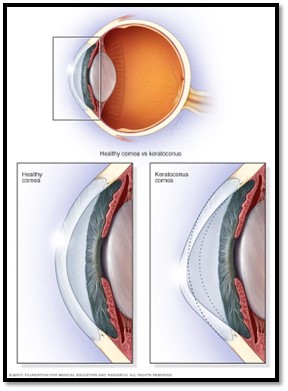 Keratoconus is a condition where the cornea, the clear, front part of your eye that looks like a dome, starts getting thinner and poking out like a cone.
Keratoconus is a condition where the cornea, the clear, front part of your eye that looks like a dome, starts getting thinner and poking out like a cone.
Because of this cone-shaped cornea, your vision goes blurry, and you become sensitive to light and glares. It usually happens in both eyes, but one eye may be more involved than the other. It usually starts affecting people when they’re in their late teens to early 30s. And guess what? This whole process can take around 10 years or even more to be noticed.
When keratoconus is just getting started, glasses or soft contact lenses might fix your vision problems. But as Keratoconus progresses, you might have to be switched to rigid, gas permeable contact lenses, or scleral lenses. In severe cases of Keratoconus, corneal transplant might be needed.
Now, there’s a procedure called corneal collagen cross-linking that could slow down or stop keratoconus. It might even save you from needing a cornea transplant later in life. This procedure can be used alongside glasses or contacts.
Symptoms
- Blurred or distorted vision.
- Increased sensitivity to bright light and glare, which can cause problems with night driving.
- A need for frequent changes in eyeglass prescriptions.
- Sudden worsening or clouding of vision.
Causes
- No one knows what causes keratoconus, although genetic and environmental factors are thought to be involved. Around 1 in 10 people with keratoconus also has a parent with the condition.
- Rubbing your eyes vigorously might exacerbate keratoconus. However, there’s not enough evidence that rubbing your eyes will cause keratoconus.
If you notice that your vision is not corrected to 20/20 with glasses, please give us a call. Dr. Silva has experience fitting specialty contact lenses for Keratoconus.
